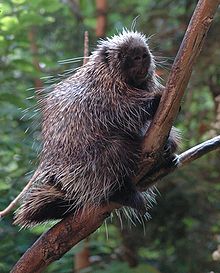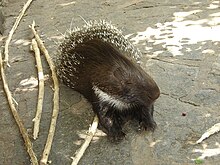Porcupine
| Porcupine | |
|---|---|

| |
| North American porcupine | |
| Scientific classification | |
| Domain: | Eukaryota |
| Kingdom: | Animalia |
| Phylum: | Chordata |
| Class: | Mammalia |
| Order: | Rodentia |
| Suborder: | Hystricomorpha |
| Infraorder: | Hystricognathi |
| Groups included | |
| |
| Cladistically included but traditionally excluded taxa | |
| |
A porcupine is a rodent with a coat of sharp spines, or quills, that defend them from predators. The porcupine is the third biggest rodent, after the capybara, and beaver. They are not to be confused with hedgehogs. Most porcupines are about 60–90 cm long, with a 20–25 cm long tail. Weighing between 12-35 pounds (5–16 kg), they are rounded, large and slow. Porcupines come in various shades of brown, grey, and the unusual white. The name "porcupine" comes from Middle French porc d'épine "thorny pork", hence the nickname "quill pig" for the animal. The correct term for a baby porcupine is a porcupette. A porcupette has soft quills made of hardened hair. This protects the mother from injury as she gives birth.[1]
The animal's quills or spines take on many forms, depending on the type, but all are hairs coated with thick plates of keratin, and they are in the skin musculature. Old World porcupines (Hystricidae) have quills in clusters. New World porcupines (Erethizontidae) have single quills mixed with bristles, underfur, and hair.
Porcupine quills are as sharp as needles, can be removed very easily, and will stay stuck in an attacker. Unlike needles, however, the quills of New World porcupines have small, backwards-facing barbs on the tip that catch on the skin making them hard and painful to pull out. Quills are about 75 mm long and 2 mm wide. If a quill gets in the tissues of an attacker, the barbs act to pull the quill farther into the tissues with the normal muscle movements of the attacker, moving up to many millimeters in a day. Animals who try to eat porcupines can die because of quill penetration and infection. Quills can still penetrate animals and humans even after death.[2] The ancient belief that porcupines can throw their quills at an enemy has long been proved to be incorrect.[3][4]

Porcupines can live in a wide range of places in tropical and mild parts of Asia, Italy, Africa, and North and South America. Porcupines live in forests, deserts and grasslands. Some live in trees, others stay on the ground.
Porcupines in search of salt sometimes live in human places, eating plywood cured with sodium nitrate,[5] certain paints, and tool handles, footwear, clothes and other items that have been coated in salty sweat. Porcupines like going near roads in areas where rock salt is used to melt ice and snow. They are known to gnaw on vehicle tires or wiring coated in road salt. Salt licks placed nearby can stop porcupine damage.
Natural sources of salt used by porcupines include salt-rich plants (such as yellow water lily and aquatic liverwort), fresh animal bones, outer tree bark and mud in salt-rich soils.[6]
References[change | change source]
- ↑ "Reference.com". Archived from the original on 2017-03-10.
- ↑ Animal Diversity
- ↑ Encyclopaedia Britannica; Or A Dictionary of Arts, Sciences, and Miscellaneous Literature. Archibald Constable. 1823. p. 501.
- ↑ The Natural History of Secession. Derby & Miller. 1865. p. 78.
- ↑ Morrisson, Philip; Morrisson, Phyllis (March 2001). "Wonders: The Needy Porcupine". Scientific American. Retrieved 2007-06-29.
- ↑ Olson, Rich; Andrea M. Lewis (May 1999). Porcupine Ecology and Damage Management Techniques for Rural Homeowners (PDF). University of Wyoming, Cooperative Extension Service. p. 4. Archived from the original (PDF) on 2007-12-03. Retrieved 2007-06-29.
